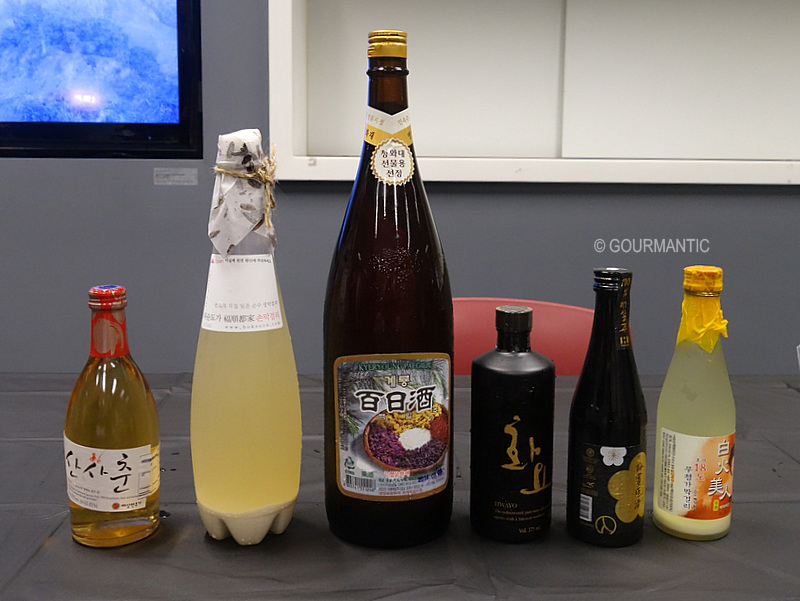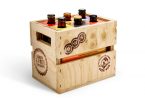The Korean Cultural Centre Australia held its annual Korean Banquet Showcase, this time with a focus on Korean alcohol.

Julia Mellor, an Australian who has lived in Seoul for nearly ten years, shared her expert knowledge in Korean traditional alcohol with a hands-on demonstration on how to makgeolli.
Makgeolli is a light, milky and effervescent brew made from rice, water and nuruk, a fermentation starter. Once fermentation has come to an end, the brew splits into two distinct layers: The bottom layer is called Takju and has a milky sediment, the top layer is golden in colour and clear and called Cheongju or Yakju. The brew that is filtered and diluted is Makgeolli. For more information, refer to the Essential Guide to Korean Traditional Alcohol.
The tasting event took place over dinner and here are the tasting notes of the brews, spirits and Korean wines.
Korean Traditional Alcohol Tasting Notes
Sansachoon Cheongju/Yakju
Made from 100% rice and nuruk, Cheongju/Yakju is the top layer of the ferment as per the process described above. It is infused with Sansa Berries from the Hawthorne tree, a small red bitter berry with acidity and bitter aftertaste. The brew undergoes natural fermentation without chemical sweeteners.
- ABV: 14%
- Colour: clear, pale yellow
- Nose: funky aroma, fruity, a little floral
- Palate: berry-like, elegant on the palate, fruity and tart with a good mouthfeel
- Finish: a pleasantly mildly bitter finish
Boksoondoga Makgeolli
Made from 100% rice and nuruk, this makgeolli is fresh and unpasteurised and cannot be found outside of Korea. Brewed by hand using Korean traditional clay pots “hangari”, it is highly carbonated hence it is referred to as “Champagne Makgeolli”. The drink balances sour and sweet with a strong lactobacillus somewhat yoghurt flavour profile.
- ABV: 5%
- Colour: milky, highly carbonated, bubbles in liquid
- Nose: subtle aromas, very faint, almost indistinguishable
- Palate: Sweet, fizzy, slightly acidic and sour, effervescence on the tongue, very mild flavour, sour and sweet, almost creamy like a sour yoghurt
- Finish: very short
Best sipped very cold.
Gyereong 100 Day Wine Cheonju/Yakju
Made 100% rice and nuruk, this ancient recipe that calls for 100 days of fermentation and has been brewed by this family in generations. Infused with pine needles, omija (five flavour berries – sweet sour bitter taste) chrysanthemum and azalea flowers, it has fragrant aromas of pine and earthy grass, a light body but strong and complex flavours.
- ABV: 14%
- Colour: bright yellow, clear
- Nose: dry, pine freshness
- Palate: bitter and bone dry, pine character as found in some gin botanicals, similar to a vodka with a stone fruit note
- Finish: stone fruit nuts, bitter
Hwayo Soju
Soju is usually bottled around 25% ABV but Hwayo Soju is one of the first large commercial producers of high ABV additive free soju. This one comes in at 41%ABV. Made from 100% rice, it uses water from 150 metres underground for a clean flavour. The spirit is distilled once and aged in Ongi (ceramic pots) to mellow out flavours for 3 months.
- ABV: 41%
- Colour: clear, transparent
- Nose: fruity, plums, rice aroma,
- Palate: pleasant strong and crisp alcohol burn, grain flavour, dry, complex, delicious, clean, crisp flavour
- Finish: long and dry
Maesil Wonju Black Gwasilju (Fruit Wine)
Made from 100% plums and honey bee honey, it uses large golden plums not green plums like many producers. The fruit wine is aged for 3 years before release.
- ABV: 20%
- Colour: yellow and clear
- Nose: sweet honeyed plums
- Palate: syrupy, plum notes with intense sweetness, heavy on the palate, liqueur style
- Finish: very sweet with a nutty end note
Choga Baekhwamiin Takju
Made from 100% rice and nuruk, this Takju is bottled fresh after filtration with no additional water added. As it is pasteurised, it can be enjoyed warm.
- ABV: 18%
- Colour: milky white
- Nose: mild rice aromas
- Palate: silky palate, mildly sweet
- Finish: a surprisingly dry finish
Photo © by Gourmantic – Copyright: All rights reserved.





